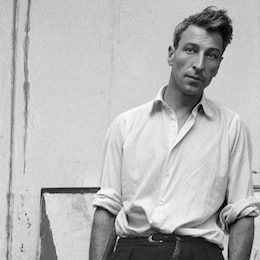Nicolas De Staël
1914 (Saint-Petersbourg (Russie)) / 1955 (Antibes)
We must do justice to Nicolas de Staël, against the critics who scoff at his "return to figuration". Whether in his nudes, figures or landscapes, the work of his last years is driven by the same principles. This can be seen in the landscapes painted in the North, in Gravelines, the implacable cliffs of the Normandy coast, the port of Antibes, or in his flamboyant series on Sicily: far from the picturesque or naturalism, Staël always seeks to translate a sensory experience, a lived event - thus, fascinated by the nothingness of the roads of Uzès at night, he composes a minimalist series of irregular segments of dull paint in black, green and grey. "You don't start from nothing, when there is no nature before, the painting is always bad." As Virginie Delcourt reminds us, "space, abstract or figurative, is the only reality that counts for him", while insisting on the contemporaneity of his work with the post-war philosophical thrust, which renews man's relationship to the world. Without explicit references to Sartre's existentialism and Merleau-Ponty's phenomenology, Staël affirms the simultaneous constitution of subject and object, of consciousness and reality. In appearing, things call upon all the senses simultaneously, so space must be inhabited from within and perceived as a whole: "Painting must not be just a wall on a wall. I don't oppose abstract painting to figurative painting. A painting should be both abstract and figurative. Abstract as a wall and figurative as a representation of a space. "
Photo: Denise Colomb, Nicolas de Staël in his studio, rue Gauguet, Paris, 1954, photograph © Ministère de la Culture - Médiathèque du Patrimoine, Dist. RMNGrand Palais/ Denise Colomb / Press Office, MuMa le Havre
We must do justice to Nicolas de Staël, against the critics who scoff at his "return to figuration". Whether in his nudes, figures or landscapes, the work of his last years is driven by the same principles. This can be seen in the landscapes painted in the North, in Gravelines, the implacable cliffs of the Normandy coast, the port of Antibes, or in his flamboyant series on Sicily: far from the picturesque or naturalism, Staël always seeks to translate a sensory experience, a lived event - thus, fascinated by the nothingness of the roads of Uzès at night, he composes a minimalist series of irregular segments of dull paint in black, green and grey. "You don't start from nothing, when there is no nature before, the painting is always bad." As Virginie Delcourt reminds us, "space, abstract or figurative, is the only reality that counts for him", while insisting on the contemporaneity of his work with the post-war philosophical thrust, which renews man's relationship to the world. Without explicit references to Sartre's existentialism and Merleau-Ponty's phenomenology, Staël affirms the simultaneous constitution of subject and object, of consciousness and reality. In appearing, things call upon all the senses simultaneously, so space must be inhabited from within and perceived as a whole: "Painting must not be just a wall on a wall. I don't oppose abstract painting to figurative painting. A painting should be both abstract and figurative. Abstract as a wall and figurative as a representation of a space. "
Photo: Denise Colomb, Nicolas de Staël in his studio, rue Gauguet, Paris, 1954, photograph © Ministère de la Culture - Médiathèque du Patrimoine, Dist. RMNGrand Palais/ Denise Colomb / Press Office, MuMa le Havre
Artist's exhibitions
Nicolas de Staël
15/09/2023 - 21/01/2024
(Paris) Musée d'Art Moderne de la Ville de Paris
15/09/2023 - 21/01/2024
(Paris) Musée d'Art Moderne de la Ville de Paris
Nicolas de Staël, l’espace en liberté
07/06/2014 - 09/11/2014
(Le Havre) MuMa - Musée d’art moderne André Malraux
07/06/2014 - 09/11/2014
(Le Havre) MuMa - Musée d’art moderne André Malraux
artist_books
Nicolas de Staël. Peintures et Dessins.
Jean-Claude Marcadé Hazan Surmontant le dualisme séparant l’abstrait du figuratif dans les années 1950, Nicolas de Staël est avant tout le peintre d’un nouvel espace. Il ne représente pas le monde qu’il voit, il “monte”, d’après l’auteur, des tableaux de lumière qu’il vit. Sa poétique fait se manifester êtres et choses en les gardant intacts – le perçu et le perce ...
